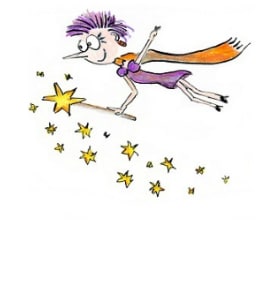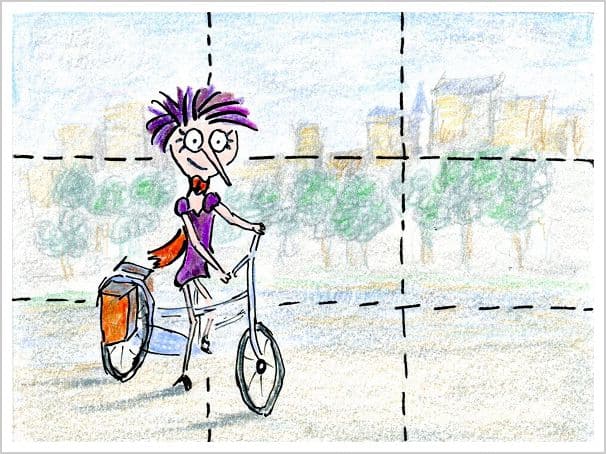The rule of three adds a sense of poetry and rhythm to your writing, making your content more pleasurable to read. But how do you harness the power of three?
This article covers:
Examples of the rule of three in Apple’s web copy
Is three really a magic number?
Examples of the power of three in headlines
Repetition and the rule of three
An element of surprise
Extra examples of the power of three
![]()
The rule of three in writing
 Uneasiness has crept up.
Uneasiness has crept up.
Heather Fields has been a freelance copywriter for several years.
Her clients seem happy; and she knows her content is engaging, persuasive, and mostly free from grammar mistakes.
But she also senses something is missing.
A little “je-ne-sais-quoi.”
Does her writing lack flair? A sense of poetry? Is the rhythm out of sync?
On a lazy Sunday afternoon, Heather browses the web, thinking about buying a new MacBook. Or should she go for a Windows laptop?
She opens the Apple website.
And there she notices it …
The rule of three in Apple’s copy
Apple’s copywriters know how to harness the power of three:
Thin. Light. Powerful.
And:
Ready. Set. Done.
And:
Which makes it reliable, durable, and quiet.
Is that the magic power of three? Is that what’s been missing in Heather’s work?
Paying closer attention, she sees groups of three phrases on almost every Apple web page:
And with Apple Pay, you can unlock an entire world of online shopping that’s fast, convenient, and secure.
iPad mini 4 runs iOS 9, the most intuitive, advanced and secure mobile operating system in the world.
Which means everything you do — playing games, surfing the web, enjoying photos and videos — becomes more personal, immediate, and immersive.
Is three a magic number?
Copyblogger founder Brian Clark explains the power of three by referring to the three-act story structure and to the Three Little Pigs, the Three Blind Mice, Goldilocks and the Three Bears, the Three Musketeers, the Three Wise Men, and the Three Stooges.
It’s no accident that the number three is pervasive throughout some of our greatest stories, fairy tales, and myths.
~ Brian Clark
If you’ve joined a photography or drawing course, you may have come across the rule of thirds, too.
To create balanced pictures, don’t put a key feature in the middle. Divide your canvas in three equal horizontal and three equal vertical slices, and put your key feature on one of the cross sections, like this:
Three seems magical, right?
But what about the number two? Why do we have two arms, two legs, two ears, and two eyes? Isn’t two the smallest number required for creating symmetry?
And symmetry is related to beauty. Isn’t that magic?
As the New York Times reports, research has suggested that three arguments may be more persuasive than two or four. But the scientific proof for the persuasive power of three remains hazy.
Trios may or may not be more persuasive, but they can create a sense of poetry and rhythm, making our content more pleasurable to read and adding stress to a statement.
Pay attention to good writing, and you see threes popping up everywhere.
Examples of the power of three in headlines
Three adjectives, verbs or nouns can add extra power to your headlines:
- A Brief Guide to Fixing Your Old, Neglected, and Broken Content
- How to Stay Healthy, Happy and Combative in Impossible Political Times
- 37 Tips for Writing Emails That Get Opened, Read, and Clicked
- How to Run Your First Webinar (with No Skills, No Stress and No Budget)
Alliteration can add extra flair:
- The Underused Writing Trick That Makes You More Powerful, Popular and Persuasive
- 53 Freelancing Mistakes That Are Costing You Clients, Cash, and Credibility
And when you use a three act story for your blog post, you can also use the same three acts for your headline. For example:
- On Dying, Mothers, and Fighting for Your Ideas
- The Snowboard, the Subdural Hematoma, and the Secret of Life
Repetition and the rule of three
You may have heard repetition in writing is bad.
But that’s only true for accidental repetition.
When used with care, repetition can add stress and a pleasant sense of rhythm. For instance, note how the phrase “we can’t” is repeated three times:
As writers, our toolbox may seem limited. We can’t shout. We can’t use body language. We can’t even bang on a table to add weight to a message.
Following the rule of three religiously, however, becomes monotone and dull. So, use trios in moderation.
In the following fragment, for instance, the phrase “How often” is repeated twice and then the phrase “Life is too short” is repeated thrice:
How often do we read content that surprises and delights?
How often are we really inspired by a blog post?
Life is too short for monotone voices. Life is too short for wishy-washy writing. Life is too short to regurgitate ideas without adding value.
It’s time to have fun, infuse your content with your personality, and dazzle your readers with your words.
Add an element of surprise
In all the examples so far, the 3 phrases seemed to form a logical trio such as powerful, popular, and persuasive; and old, neglected, and broken.
When you break your reader’s expectation of what’s coming next, you add an element of fun and surprise to your writing.
Here’s an example from Grace Dent’s memoir Hungry:
Dinner consisted of three stainless-steel terrines of mushy, lukewarm, delicious chips sat close to warm jugs of lumpy, powder-based gravy.
Mushy and lukewarm both have negative associations, so you’d expect a third negative word to turn up, but no. Dent breaks the expectation by introducing the word delicious. The abrupt change from negative to positive shakes expectations and makes readers pay attention.
Here’s another example from the same book; note that sketty means spaghetti:
Dad’s sketty is always, always delicious. Comforting, sweet and gloriously stodgy, because Dad boiled the pasta for at least thirty to forty minutes too long.
Gloriously stodgy is not a phrase you’d expect to come after comforting and sweet, right?
Veni. Vidi. Vici.
I came. I saw. I conquered. ~ Julius Caesar
The number three is the smallest number to create a pattern; and patterns please our minds.
So go ahead.
Use the magic of three in your content.
Add a dash of flair. A sprinkle of rhythm. And a dollop of poetic beauty.
Your readers will hippety-hop through your content, with a smile on their face.
Have fun!
![]()
Extra examples of the rule of three
From Raymond Chandler’s The Big Sleep:
Shaved, dressed and lightly breakfasted I was at the Hall of Justice in less than an hour.
And:
He was a medium-sized blondish man with stiff white eyebrows, calm eyes and well-kept teeth.
And:
The man was long-legged, long-waisted, high-shouldered and he had dark brown eyes in a brown expressionless face that had learned to control its expressions long ago.
From Raymond Chandler’s Farewell, My Lovely:
It was a long narrow room, not very clean, not very bright, not very cheerful.
From E.B. White’s Here is New York:
The city has never been so uncomfortable, so crowded, so tense.
From Elif Shafak’s 10 Minutes 38 Seconds in this Strange World:
As Leila’s brain fought on, she remembered the taste of soil – dry, chalky, bitter.
From Kyo Maclear’s Birds Art Life Death:
A lull can be soothing, tranquilizing, and even restorative. It can be a time to retune and replenish. A lull can suggest a state of peaceful hovering, a prolonged mental daydream, a weightless interval.
From John McPhee’s Draft No. 4: On the Writing Process:
A piece of writing has to start somewhere, go somewhere, and sit down when it gets there. You do that by building what you hope is an unarguable structure. Beginning, middle, end.



This is so informative and helpful for any style of writing. And I like your idea that “Pay attention to good writing, and you see threes popping up everywhere.”
Happy “three spotting”, Michael!
Thanks for sharing. you are saying absolutely right And I agree with your idea that “Trios may or may not be more persuasive, but they can create a sense of poetry and rhythm, making our content more pleasurable to read and adding stress to a statement.”
Thank you, Sarah. Have fun with the magic of three in your writing 🙂
This is so informative and helpful for any style of writing. I’ve taught writing for years and often invoke the Rule of Three for my students.
Your students are lucky you’re teaching this! 😉
As my father used to say: a three legged table always stands solid 🙂
Yep, that’s a good one! My parents used to have a three-legged round table. I didn’t really think about that. 🙂
I like the reference to the three little pigs and three blind mice – are these stories the things that have trained us to think in threes, or were they simply following a much older rule.
There’s the Holy Trinity, for example. It could be to do with triangles being the strongest shape. All I know is when I write a list of anything in a sentence, three things feels OK. Two seems to be missing something and once you get to four it feels awkward.
I read that many world religions have the concept of trinity. Perhaps that suggests that thinking in threes pre-dates the three little pigs and three blind mice? It’s an interesting philosophical question!
The strength of the triangle is another interesting point.
Thank you for stopping by to add your thoughts, Steve. I appreciate it!
I smiled when I saw your cartoon — I was just teaching the Rule of Thirds last night to one of my live classes :).
Thank you as always for so many examples. I know it takes time to fin them , and to link to other great blog posts, and yet you over-deliver on examples each week. It makes all the difference.
I’m happy when I can make you smile, Alison 😀
And you’re absolutely right – it’s a lot of work to find all the right examples, but it’s fun, too!
Always good to see you here!
You inspired those words Henneke,
Thank you.
You writing is always cheerful, concise and comprehensive.
Always captivated,
Yours truly.
🙂
“Cheerful, concise and comprehensive” – That’s a lovely trio 🙂
Thank you for your compliment, Nicolas.
Enchanting as always, Henneke! 🙂 I’ve found myself using this technique sometimes in the past without realizing it. Now I can be more deliberate and effective!
Thank you, Mike 🙂
I’m not surprised you’ve been using the power of three without realizing it. I think it’s a natural rhythm.
Happy writing!
Interesting! It’s not just in the written word where three works. I use it a lot in my design work. It has a balance, a visual equilibrium that just works. A triptych of ideas. Glad you had a lovely holiday and feeling ready for the new term 🙂
Ha, yes! It does feel a little like the start of a new term. Fortunately, term time is fun for me 🙂
Good to “see” you again!
Henneke,
This is an eye-opening post! Love that the Rule of 3 can create a sense of poetry and rhythm. Sometimes, people write just to express themselves or share information, often forgetting that point of making the written piece a “pleasurable to read”
Looking forward to more posts from you. This is truly an enchanting read 🙂
I love the process of transforming dull text into content that’s a pleasure to read. I find it a lot more fun than writing a first draft!
Thank you for stopping by, Jones. Nice to “meet” you! 🙂
Henneke,
Powerful post on the power of threes. This is actually the first time I heard about it, but thanks to your examples, I can see exactly where it ticks. I’ll try to incorporate it into my writing. 🙂
Thanks for sharing and making me think.
Cheers,
Anh
It was so much fun to find the right examples and weave them into the post!
I’m glad you enjoyed this one, Anh. Have fun with applying it to your writing 🙂
Dear Henneke,
I read, save, and then re-read everything you send me.
I have no URL yet, but because of you, I still believe I will get there.
Thanks so much.
Judy Fisher
“Read, save, and then re-read” – You’re a natural when it comes to using the magic of three!
Good luck with your website, Judy. Let me know if you have specific questions?
Am I (65+) too old to be taken seriously?
I’m drowning in fear about it.
Age for me is positive – you have more wisdom to share than younger people.
I also think that people pay attention to the people whose voice and ideas resonate with them – it’s less about age or location, and more about being like-minded spirits and having something to share that resonates.
Thank you Henneke.
You make a lot of sense– I need to let go of my age phobia and focus on my writer’s voice.
I’m going to get busy doing just that!
With Much Gratitude,
Judy
Hey Henneke,
Welcome back from your hols. You are really cooking! I am a believer in the enchanting power of 3. It really works. 3 separate raw ingredients (words/sentences), that when combined together in the right measure, magic happens and they are transformed into something special (an experience). Pure alchemy!
Pure alchemy. True enchantment. Or a touch of magic.
Whatever it is, it works 🙂
You’re very perceptive – I was enjoying writing this post. It’s good to be back, and to “see” you again 🙂
Another great post Henneke!
To follow on from your article, I read recently that odd numbers (including 3) leave the reader/viewer with a sense of ‘something’ missing. Apparently, this creates a natural impulse to discover the missing element.
Could this be one of the factors why 3 is a magic number?
Yes, maybe! Interesting point – I haven’t heard about that before.
I guess that perhaps we look for symmetry and therefore think that odd numbers are missing something?
Thank you for stopping by to add your thoughts, Craig. I appreciate it.
Yes, I think that’s exactly it.
This short article explains it clearer than I ever could… http://www.photokonnexion.com/the-rule-of-odds-uneven-composition/
Interesting! Thank you for sharing.
Here’s another magic of three’s saying: “The third time is a charm”.
It may be magic because our brains don’t want to digest more than three things.
Hmmmm…..
Ah yes… The third time is charm. That’s a good one!
I also read about our brains not wanting to digest more than three things, but some of information contradicting this, so I checked with my husband (who’s a cognitive psychologist) and he said it’s a myth.
Good to see your smiling face again!
Hi Henneke,
When I read the title I imagined that the power of three would refer to old-style public speaking: Tell them what you’re going to say, tell it to them, and tell them what you’ve said.
But I loved reading your examples of three. And I believe that three has a natural rhythm.
Thanks for the inspiration!
– David
I find that old-style advice (telling what you’re going to say, tell it, then tell them what you’ve said) a little boring. I’m glad you still clicked through to read the post and that you enjoyed it!
Thank you for stopping by, David! 🙂
I was beginning to worry that I was obsessed with trios. Glad to have a better reason for using them… other than “it just sounds better”.
Thanks for another great article, Henneke!
Go for it, Christiana. Indulge in your obsession. I do it, too!
Thank you for commenting.
I love the magic of three and use it often in writing. I don’t know why. Maybe because it seems so…balanced, complete, and lyrical!
Balance, complete, and lyrical …
That’s it!
Thank you for stopping by again, Laurie. I appreciate it.
Bonjour and happy to see your magic writing back here 🙂
I have noticed lately that each time I was working on a tagline, despite starting with one or two favorite words, I ended up with three because of the rhythm.
Bonjour, Thuy 🙂
And great suggestion about taglines. Some famous taglines have three words. The ones popping into my mind …
Just do it
A diamond is forever
Vorsprung durch Technik (just to make this a little more multi-lingual 😉 )
The rule of thirds, however, tells you to put an object off-center. It has, as far as I can see, no bearing on the rule of three.
Yep, that’s true – the only relation is that the rule of thirds and the rule of three are both somehow related to the number 3.
Delightful. Relevant. Poetic. Loved this post. Loved your drawings. Love the magic of three!
😉
Bettina
What a lovely comment!
Thank you, Bettina 🙂
Henneke,
Superb stuff. The power of 3 is very important but what I didn’t know was how powerful it was and how prevelant it actually is in headlines.
You have taught me something new here, my friend. Thank you for this great post.
– Andrew
It’s pretty crazy. Once you start paying attention, you see the power of three everywhere.
Glad you enjoyed this one, Andrew. Thank you for tweeting it, too.
Lovely to have you back on deck Henneke – I’m sure you had a marvelous holiday.
And yes, I couldn’t help but notice the French before the Apple website example 😉
I did enjoy the article – thank you.
Cheers
Mark
I had a fabulous holiday (it’s soooo good to switch off for a while!) but I’m also happy to be back 🙂
I wasn’t sure whether you’d smile at the Apple examples or whether you’d roll your eyes 😉
Good to “see” you again, Mark!
I discovered the power of three, Henneke, not only helps my copywriting, it helps organize my thoughts. I am a lover of outlines and the power of three maps out my content. After all, books have a beginning, middle, and end. 😉
Another great post, Henneke, that is simple, clear, and uniquely yours. 🙂
So true: a beginning, a middle, and an end – that’s how I write all my blog posts, too 🙂
Thank you for your lovely comment, Cathy.
I love the examples of how pervasive the number 3 is through our psyche, our images, and in our storytelling. 😉
It’s amazing, isn’t it?
Hi Henneke ,
Love this post : fresh, short and useful.
And as a french reader of Enchanting Marketing, I can say I liked the “je-ne-sais-quoi.” expression 🙂
By the way, I created a free ebook and named it with the rule of three.
In english, it says “10 Secrets for Posts that get Read, Shared and Commented” (hope I translate this right).
According to you, is it a good title ?
Thanks for share good content like this one !
I wasn’t sure whether non-French speakers would be happy with “je-ne-sais-quoi,” but I decided to risk it 🙂
The title sounds pretty good. In English, the word “secrets” is a tad overused (and rarely refers to real secrets), so in English I’d probably go for “little-known tips” or something similar. But this may be different in French!
Salut!
The phrase je ne sais quoi is ot typically written with hyphens. Think of savoir faire for instance, or amour propre.
LR
I didn’t know there was a prescribed way of writing je ne sais quoi. I found that many English speaker don’t even know the phrase. I’ll change it!
Your ideas always bring a big smile on my face. Your ideas create a ocean of possibilities in my mind. Your ideas always leave behind a meaningful impact on my writing.
Thank you, thank you. Thank you! 🙂